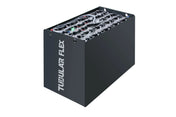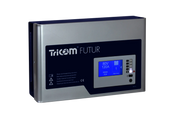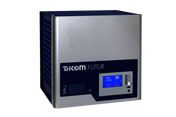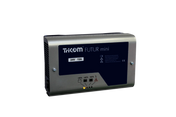If you charge a forklift battery incorrectly, you risk more than just a loss of performance. Overheating, sulfation, and cell damage are typical consequences that can be reliably avoided with proper charging. This guide shows you how to charge forklift batteries safely and efficiently , which technical specifications are important, and how you can significantly extend their service life with just a few simple steps.
Why the right charging process is crucial
Every traction battery—whether in a forklift , pallet truck , or order picker—has only a limited number of charging cycles. A lead-acid battery typically lasts between 1,200 and 1,500 charging cycles , which corresponds to approximately 6,000 operating hours . Incorrect charging or excessive discharge significantly shortens this lifespan.
However, if you charge the battery in good time , maintain it regularly and use the right charger, you can significantly extend its service life and reduce energy consumption.
What types of batteries are there?
Traction batteries are divided into three main types: PzS, PzB, and PzV batteries . The designation indicates their construction, maintenance requirements, and application.
- PzS – armor plate batteries with liquid electrolyte. They are robust, deep-cycle, and the standard in forklifts. Require regular maintenance and water refilling.
- PzB – "British Standard" batteries with an identical operating principle but different cell dimensions according to British standards. Also maintenance-intensive, but common in older imported forklifts.
- Maintenance -free gel or fleece batteries. The electrolyte is bonded, preventing gassing. Ideal for indoor use, but more sensitive to deep discharge.
All types require adjustment on the charger side , as their characteristics vary. Incorrect adjustment can significantly shorten their service life.
When is the right time to charge?
The optimal charging time is when the remaining charge is between 20 and 30 percent . Below this level, sulfation begins – lead sulfate crystallizes on the plates and reduces capacity. Deep discharge below 10 percent should be avoided at all costs.
Opportunity charging during short breaks is not advisable for lead-acid batteries, as it increases the number of charging cycles and thus shortens their service life. With modern lithium-ion batteries, however, opportunity charging is permitted and even beneficial.
Preparation: Environment, temperature and safety
Before each charging process, the charging area should be clean, dry, and well-ventilated . Charging generates hydrogen gas , which is explosive at a concentration of 4% by volume . The concentration should therefore remain below 2% by volume . According to EN 50272-3, the ventilation system must be designed to ensure the gases are safely removed.
The ventilation should continue running for at least one hour after charging is complete . The ideal battery temperature for charging is around 30°C . Charging below 10°C or above 55°C should be avoided. Modern chargers automatically adjust the charging voltage using temperature compensation .
Safety measures when charging
When handling traction batteries, the requirements of DGUV Information 209-093 apply. Personal protective equipment is mandatory: Acid-resistant gloves, safety goggles, and an apron prevent injuries from electrolyte. Furthermore, only insulated tools should be used, as high currents flow across the terminals.
Open flames, smoking, and sparks are strictly prohibited in the charging area. If a charging error occurs, the charger must be turned off immediately and the connection checked. Damaged cables or plugs must be replaced immediately.
This is how the charging process works correctly
1. Preparing the battery
Before charging, the forklift is turned off and the battery is disconnected from the vehicle's electrical system. Only then is the charger connected . The connectors must be secure, clean, and free of corrosion. Foreign objects or moisture can cause short circuits.
2. Main charge
The charging process follows the IU or IUI characteristic curve according to DIN 41773/41774 . First, charging occurs with a constant current (I phase) until the gassing voltage of approximately 2.4 V per cell is reached. This is followed by the constant voltage phase (U phase), in which the current gradually decreases.
Depending on the battery capacity, charging takes 6 to 10 hours . High-frequency chargers with electrolyte circulation (EUW) reduce charging time by up to 30 percent and ensure even electrolyte mixing.
3. Gassing and equalizing charge
Once the final charging voltage is reached, the gassing phase begins. This gently circulates the electrolyte, and voltage differences between the cells are equalized. Regular equalizing charging is necessary if the battery is discharged unevenly or has not been used for an extended period.
For the equalization charge, the voltage is raised to 2.6 to 2.7 V per cell . The process typically takes about two hours and should be stopped once the voltage and electrolyte density remain constant for at least two hours . Only then is the battery fully balanced.
4. Cooling phase
After fully charging, the battery must cool down for at least two hours before being reinserted. This rest period prevents thermal overload and material stress in the plates.
What is important after charging
Check electrolyte and water level
After the cooling phase, the water level should be checked. For conventional lead-acid forklift batteries , distilled water should be topped up regularly to keep the electrolyte level constant. The target level is between the "Min" and "Max" markings on the cell.
Refilling should always be done after charging , never before. During charging, the electrolyte can outgas and overflow. The electrolyte should have a density of approximately 1.28 kg/l (fully charged) and 1.13 kg/l (discharged) . This is checked with an areometer or refractometer .
Cleaning, testing and isolation
After each charging session , the housing, cell connectors, and terminals must be checked. Deposits, traces of acid, or corrosion impair performance and can cause leakage currents. Regular cleaning with a damp, non-conductive cloth will maintain functional reliability.
An insulation resistance test according to DIN VDE 0117 is also recommended. This test detects damp or damaged cells early and prevents short circuits. This test should be performed regularly as part of maintenance.
Choosing the right charger
50 Hz vs. high frequency chargers
Older 50 Hz chargers use transformers and are robust, but heavy and less efficient. They cause higher heat losses and longer charging times. Modern high-frequency (HF) chargers operate with electronic control, are lighter, more efficient, and reduce energy consumption by up to 20 percent.
HF chargers dynamically adjust current and voltage and offer features such as temperature compensation, electrolyte circulation , and equalization charging . This ensures more even charging and protects the battery. At HK Handels GmbH, you'll find suitable chargers for all common voltages and battery types.
Charging lithium-ion forklift batteries
Lithium-ion forklift batteries are largely maintenance-free, as they don't require water refilling and don't emit gas. They have a higher energy density, require less maintenance, and allow for opportunity charging during breaks.
Charging time is usually only 1 to 2 hours . A battery management system (BMS) monitors the voltage, current, and temperature of each cell and prevents overcharging. The charger must be precisely matched to the battery type and have protection features against short circuits and overheating.
Maintenance, testing and regeneration
Regular operational testing
A field test should be performed by a qualified technician at least once a year. This involves measuring the voltage, capacity, and internal resistance of each cell. Cells with less than 2.12 V are considered weak and should be checked.
Regeneration of forklift batteries
When performance drops, a new battery isn't always necessary. Sulfated cells can be partially restored through battery regeneration . Modern processes enable capacity recovery of 70 to 95 percent and significantly extend service life. HK Handels GmbH offers expert support and analysis of existing battery systems for this purpose.
Conclusion: Charging correctly is worthwhile
Charging a forklift battery correctly isn't rocket science – it does require attention and practice. Charging at 20 to 30 percent residual charge , using the right charger , ensuring good ventilation , and regularly checking the water level will significantly extend the lifespan of your battery.
Whether you're looking for a traditional lead-acid battery or a modern lithium-ion solution , careful charging and professional maintenance reduce operating costs, prevent breakdowns, and increase safety in daily use. HK Handels GmbH offers experience and expertise for advice, reconditioning, or the purchase of a new battery.







